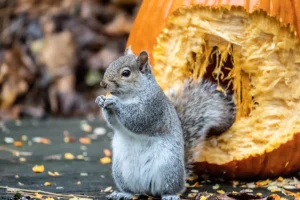Home / Blog / How to Identify Mouse Droppings
How to Identify Mouse Droppings

Scientifically reviewed by Daniel Baldwin, BCE, CCFS, CP-FS
-Published on March 24, 2023
-Updated on January 11, 2024
A mouse infestation is a common problem many homeowners face at one point or another. Mice find their way into homes in search of warmth, food, and a good hiding place. If you suspect you have a mouse problem, it’s best to take action as soon as possible. Learning how to identify telltale signs, such as mice droppings, is a helpful way to know whether you have a mouse infestation.
What do mouse droppings look like?
Mouse droppings can be difficult to differentiate from other pest droppings, such as rats and geckos. Typical mouse droppings most often resemble dark grains of rice. The average size of mouse feces is generally an eighth to a quarter of an inch in length, and you will usually find them in groups.
The best places to look for mouse droppings if you suspect an infestation are kitchen cabinets, pantries, and other food storage areas. You may even find mouse droppings in your refrigerator if the seal isn’t tight. Other places to check include closet spaces and cabinets around appliances or water heaters, bathroom storage areas, attics and crawl spaces, vents, ducts, exposed pipes, and holes in walls.

Old vs. new mouse droppings
Recognizing the age of mouse droppings help determine whether you have an active infestation or if the mice are long gone.Fresh droppings are a darker black color and have a moist sheen. Older mouse droppings usually fade to a light brownish-grey color and are very hard and dry. Keep in mind that mouse droppings can begin to look faded and old around 48 to 72 hours after they’re produced. The older they are, the more they’ll dry out, fade, and become powdery.

Rat vs. mouse droppings
It can be hard to tell mouse droppings from rat droppings. The basic rule of thumb is that rat droppings are larger and wider than mouse droppings. Their average length is between half an inch to three-quarters of an inch long. They also feature blunt, rounded ends, while mouse droppings typically come to a point on one or both ends. Rats produce about half as much waste as mice in one day, but the larger size of the waste makes the total amount relatively similar. Like with mouse droppings, older rat droppings fade to a light color and dry out.

Gecko droppings vs. mouse droppings
Gecko droppings are easier to tell apart. Gecko droppings consist of two different waste products called feces and urates. Unlike mammals, geckos only have one opening, the cloaca. The cloaca produces both feces and urates. Feces is the solid waste passed from the intestines. The urates are solid waste formed of uric acid. Gecko droppings typically take a cylindrical shape and are about half an inch long. Their droppings are usually brown, but if urate waste also passes, it could have some white coloration. The white urates are what make it easy to differentiate from mouse droppings.

Do mouse droppings spread disease?
According to the CDC, both rats and mice are known to carry many diseases. These diseases can spread to people in multiple ways, including handling the rodents directly, coming into contact with their droppings, urine, or saliva, and breathing air or ingesting food contaminated with their waste.
Some of the most common diseases spread by mouse droppings are hantavirus, hemorrhagic fever, leptospirosis, monkeypox, and salmonellosis. Mouse droppings can also contain bacteria that cause illness and difficulties for people with asthma. At the first sign of mouse droppings, it’s crucial to address the potential infestation to protect the health of your household.
How long are mouse droppings dangerous?
Many viruses can be infectious in mouse droppings for two to three days at room temperature. Time in the sun can shorten this period, but colder temperatures can lengthen it. Bacteria, such as salmonella, can stay active for several days to weeks in mouse droppings. Unfortunately, you’re still susceptible to hantavirus if you breathe in dried mouse droppings from the air. When cleaning mouse droppings, wear a face mask and gloves to help protect yourself.
How to get rid of a mouse infestation
There are several ways to attempt to eliminate a mouse infestation in your home. Below are some options:
- Use humane traps: Catch-and-release traps may be an effective way to help remove mice without harming them. Wear protective gloves when releasing the mice, and make sure to go at least two miles away from your home to prevent their return. These traps are not always the most effective compared to a professional pest control treatment plan.
- Seal any entry points: Look for holes, gaps, or cracks in your walls, ceiling, and floor. Stuff the holes with duct tape or steel wool. Mice cannot chew through these materials, cutting off their access to your home.
- Clean thoroughly: Set up a routine of deep cleaning the areas where you’ve found mice in your home. Pull out your refrigerator, stove, and other appliances. Use household cleaner and warm water while wearing gloves and a face mask to protect your skin from urine or droppings. Doing this will protect the people in your home while also limiting nesting materials for mice to find.
Pest control services
The best way to address a mouse infestation is by hiring a professional pest control company like Hawx Pest Control. We offer premium pest control services that are safe and affordable to restore peace in your home. With proven methods, qualified technicians, and the best products and services available, Hawx is the undisputed leader in pest control solutions. Our friendly professionals are ready to help you all year round. Call us today for a free estimate to get your pest problem under control.
Related Articles
Visit our blog to learn more.
→





